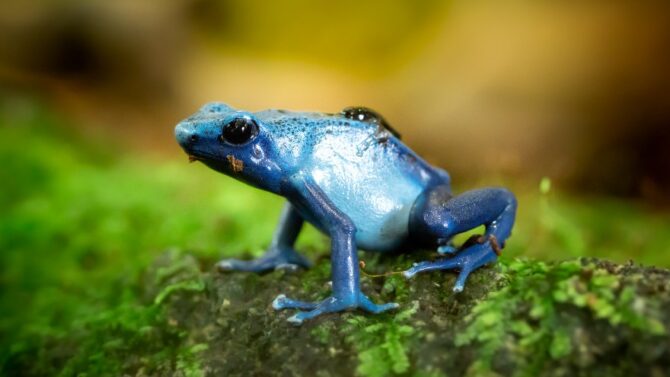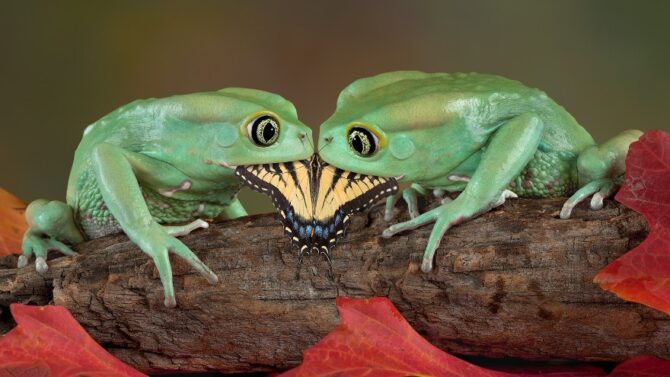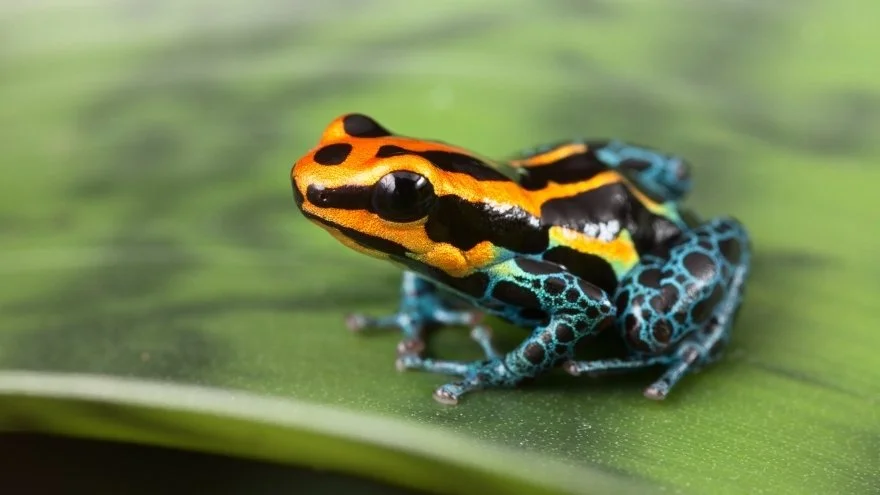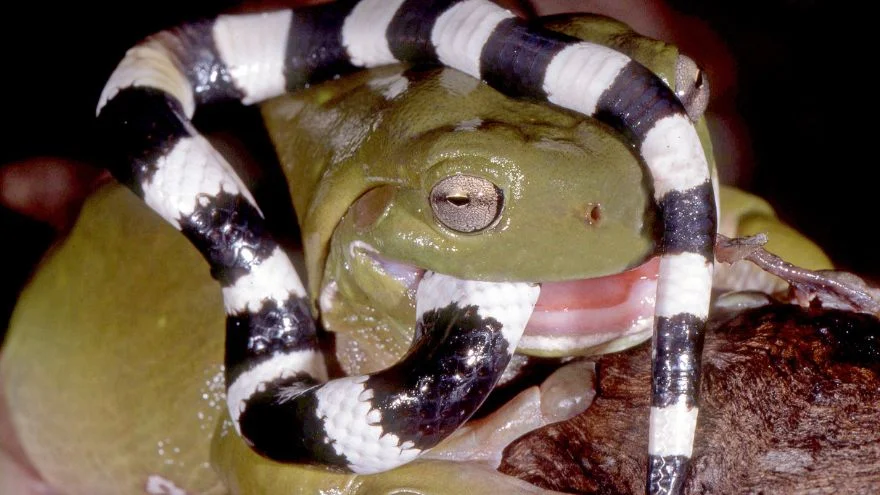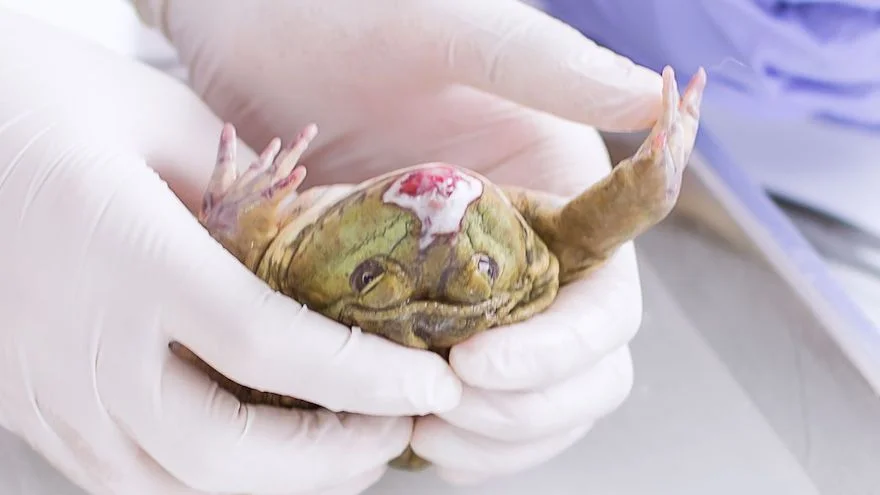All animal species eat to provide energy and nutrients for most biological processes.
While some animal species are voracious eaters, others, such as frogs, don’t need to feed every minute and can survive without food for a while without food or water.
Frogs can go without food for a long period, sometimes months or even years, depending on varying factors. Typically, healthy adult frogs can stay without food for up to 4 weeks during hibernation, while baby frogs (tadpoles) can stay up to 2 days without food.
Some factors influence the survivability of frogs without food for a long time, and we will discuss some of them in this article.
How Long Can Frogs Go Without Food?
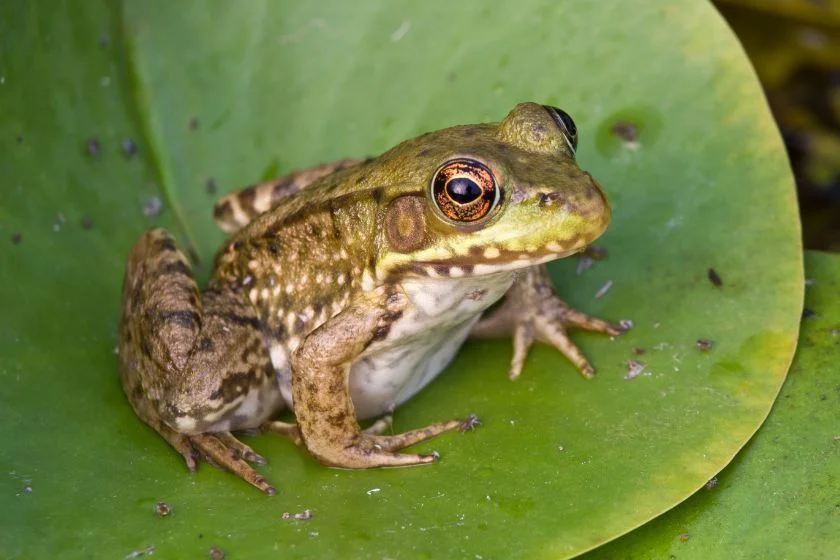
Frogs can survive without food for some time, but in the long run, it can affect their health and life expectancy.
Generally, healthy adult frogs can stay up to 3–4 weeks or slightly more without food if they are previously well-fed and live in good habitat, while adult frogs with average health can survive up to 1–2 weeks without food in similar circumstances.[1]
Some species of frogs, such as the burrowing frogs, can stay for years without food.[2]
Tadpoles or smaller frogs, on the other hand, can stay up to 1-3 days without food.
While a healthy juvenile frog can last about 3 days, well-fed tadpoles can only go 2 days without food, and tadpoles with average health can survive only 24 hours without food.
This difference is because tadpoles need more energy and nutrients as they’re still developing.
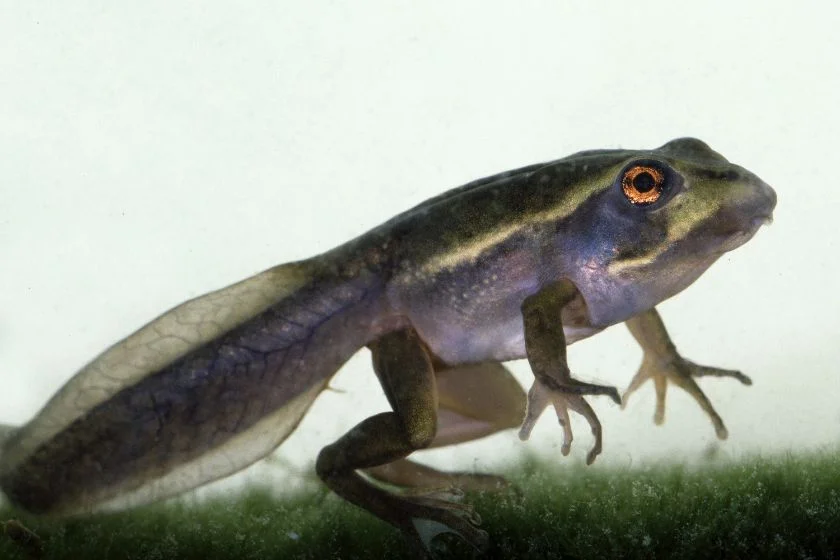
Although frogs can go for a long period without food, this doesn’t mean they will be in good health.
This is because when frogs go too long without food, their daily activities and metabolic processes are affected, which can cause many health complications.
Below is a chart that shows how long tadpoles, juvenile frogs, and mature frogs can live without food. Their survival time largely depends on the level of their health.
| Age | Average Health | Healthy |
|---|---|---|
| Tadpoles | 24 hours | 1 to 2 days |
| Juvenile Frogs | 1 to 2 days | Up to 3 days |
| Adult frogs | 1 to 2 weeks | 3 to 4 weeks |
Factors That May Influence How Long A Frog Can Live Without Food
That frogs are known to survive for a while without food doesn’t mean we should go about starving and torturing them since we know they have such ability.
A frog’s ability to stay without food for weeks is a survival trait in extreme situations; even at that, it can affect its health and lifespan in several ways.
So as a result of this, how long a frog can survive without food will depend on the following factors:
1. The Health Condition Of The Frog Before Food Shortage
A healthy frog on a good diet before food scarcity will have the ability to withstand starvation longer than a frog that has been on a poor nutritional diet.
The state of health of the frog before the food shortage will affect how long the frog can live without food.
A healthy and well-nourished frog can go longer than an injured or unhealthy frog, as frogs with poor health need more energy to carry out their daily activities.
2. The Species Of The Frog, The Size and Development Stage Of The Frog
Larger frogs will stay longer without food, while smaller frogs will last shorter without eating.
This is another factor that influences how long frogs can go without food, as the requirement for survival differs with the species and size of the frog.
Bigger-sized species of frogs like the American Bullfrog require large meals and, when they’re well fed, can go weeks without food, while smaller species of frogs feed more often and can’t last as long as big frogs without food.
Some species of frogs last for weeks, while others last for years.
3. The Time of The Year
The season and climate usually hibernate during low-temperature periods play a crucial role in a frog’s feeding process.
During winter seasons, frogs hibernate by hiding under the leaves, burrowing underground, or lurking at the bottom of a pond, depending on the species of frogs.
During summer, frogs exert themselves to protect themselves from the heat by burying themselves underground.
These behaviors of frogs help them preserve their energy by slowing down their metabolic processes, thus making them last for months without food during these seasons.
Asides from the time of the year, frogs naturally are amphibious and need water for their survival and nutrition.
So it is only natural that water scarcity, maybe due to a drought during the dry season, can force the frog into hibernation.
4. The Living Environment
Frogs that live in a safe, clean, and comfortable habitat can last longer without food than frogs that live in a dirty, unclean environment.
Frogs feel more comfortable and convenient when living in a clean environment.
They can conserve more of their energy in this kind of environment to last longer in times without food.
5. Injuries
Frogs are predators that depend on prey to survive.
So, if a frog is injured or, say, has a broken leg, it will be difficult to move about to hunt for food, which will make the frog go into freeze mode to conserve energy.
6. Age
The age of frogs will also impact the extent frogs can live without food; the older the frog, the longer the days it can survive without food.
Younger frogs need to feed more often as they grow rapidly and require the nutrients for healthy development, so they can’t last as long as adult frogs without food.
What Do Frogs Eat?
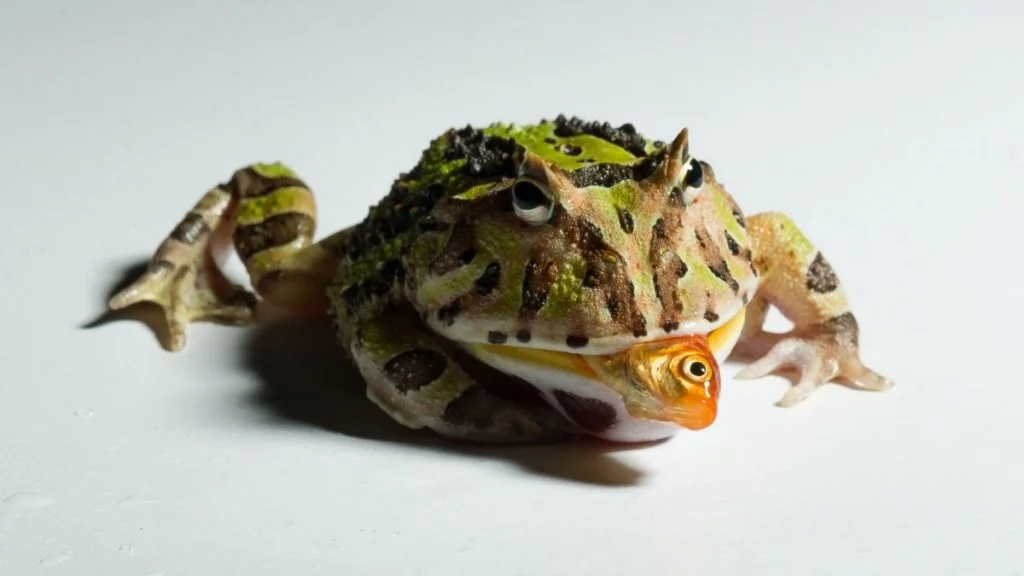
Before you bring any pet home, it’s necessary to know what they eat.
Adding pets to your home can be a good idea, but it’s also imperative to know their diet and how to feed them properly.
The truth is, frogs, in general, eat pretty much about anything that comes their way as long as it can fit their mouth, but this does not imply that we must feed them just anything we see
Insects such as crickets of the top healthiest and most nutritional diet of frogs, and the good thing about it is that you can rear them at home or purchase them from stores—asides from that, pretty much other insects like the locusts and grasshoppers.
Caterpillars and worms make good diets for frogs, but if you want your frog to derive more nutritional value from these diets, it’s important you gut-load these insects before feeding your frog.[3]
Larger species of frogs, like the giant American Bullfrog, due to their size, don’t just eat insects only but go for much larger prey such as mice, fish, birds, and even snakes.
What Do Small Frogs Eat?
Before you feed frogs, you should understand that frogs have a high metabolism.
This makes feeding them quite a chore because, being predatory, they tend to digest meals very quickly, so you must feed them regularly.
Small frogs depend on insects such as ants and mosquitoes.
You can also go out of your way by feeding them gut-loaded crickets, mealworms, and fruit flies, as these will make more nutritional value than just feeding them insects only.
What To Do If Your Frog Refuses To Eat
Whenever we get a new pet, it’s only natural to want to take care of them by feeding them.
But what if you notice that your frog won’t eat despite your efforts?
No doubt this may cause you to worry a little, but here are a few helpful tips to help during such a situation:
Perhaps you are not feeding the frog the right food.
You can look above where we talked about the proper diets for frogs, such as insects like crickets, grasshoppers, worms, caterpillars, etc.
Do you like hand-feeding your frog?
The desire to see your frog eat from your hand is understandable, but maybe you need to stay off that act for a while—drop the food in a tank, and let nature take its course.
Remember that frogs are predators; by their nature, they prefer going after living things that move around.
Your frog doesn’t feel safe yet in the new environment
Imagine someone kidnapping you and taking you to a new place and begins stuffing food into your mouth.
How will you feel?
Just like any species, your new pet frog needs to feel comfortable and safe before it can eat.
So perhaps you need to create a spot in a tank where your frog can move freely. That way, it will begin to feel safe and allow nature to take its course.
How to Save a Starving Frog
You can try a few helpful tips if you notice your frog has embarked on a voluntary starvation exercise and wish to rehabilitate it.
Although the reasons or factors for which the starvation might occur may vary, you should understand the situation and apply the one that is best appropriate.
- You can begin by changing the water in a small amount (say about 10%) to a dechlorinated one as that will improve the water quality for the frog.
- Another is that you can start by feeding the frog to food it’s normally used to, and don’t try to hand feed, as you may only startle the poor creature. Feed it sparingly at first, and then you can increase the quantity little by little as time goes by.
- Also, not all frogs are meant to be in captivity, as some species are meant to be in the wild. So, if you remove a frog in the wild from its natural habitat and intend to keep it as your pet, you must observe the habitat before you take the frog and replicate it in its new environment. If you found it in a habitat where it hops on leaves or burrows under rocks, you should introduce the same in the new place you are relocating it.
How Often Do Frogs Like To Eat?
As we stated above, frogs are carnivores and eat regularly to maintain their body metabolism.
Adult frogs can be fed once or twice a week, while smaller frogs should be fed daily.
The mantillas, on the other hand, should be fed regularly. You can also sprinkle some calcium and multivitamin supplements in the water to help improve their nourishment.
How Often Do Frogs Feed?
Juvenile frogs should be fed daily, small-sized and extremely active adult frogs should be fed every two days, and large-sized adult frogs should be fed every three days.
The feeding of frogs should be monitored, especially when they’re taken as pets, because excess food consumption can harm the frog’s health.
How Do Frogs Eat?
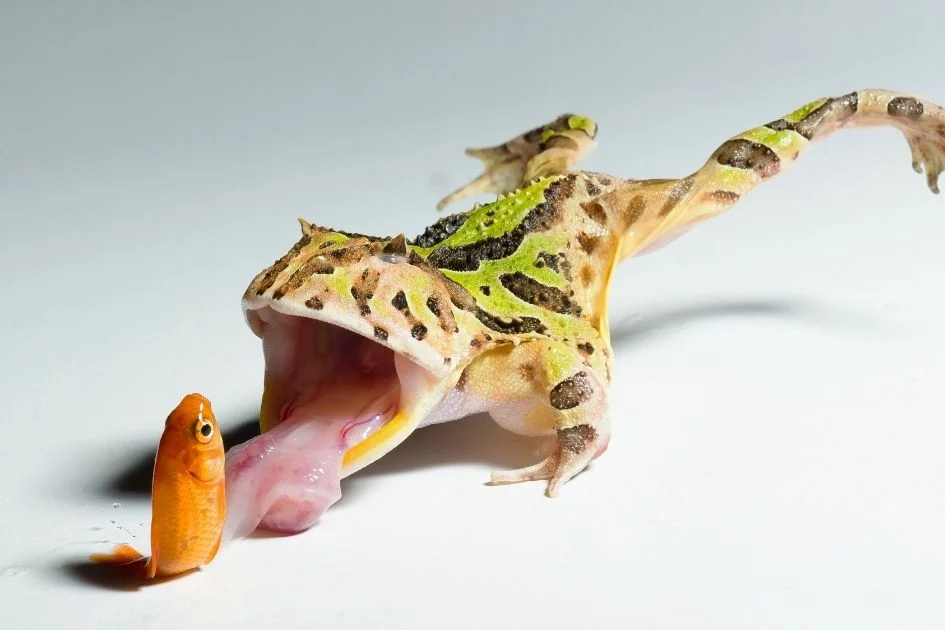
Frogs use their long tongues and sticky saliva to catch prey in their surroundings.
They don’t chew; they lick their prey and swallow using their eyeballs.
The frogs put their eyes down into the roof of the mouth to help push food down the throat, which explains why frogs blink when eating.
How Long Can Frogs Go Without Water?
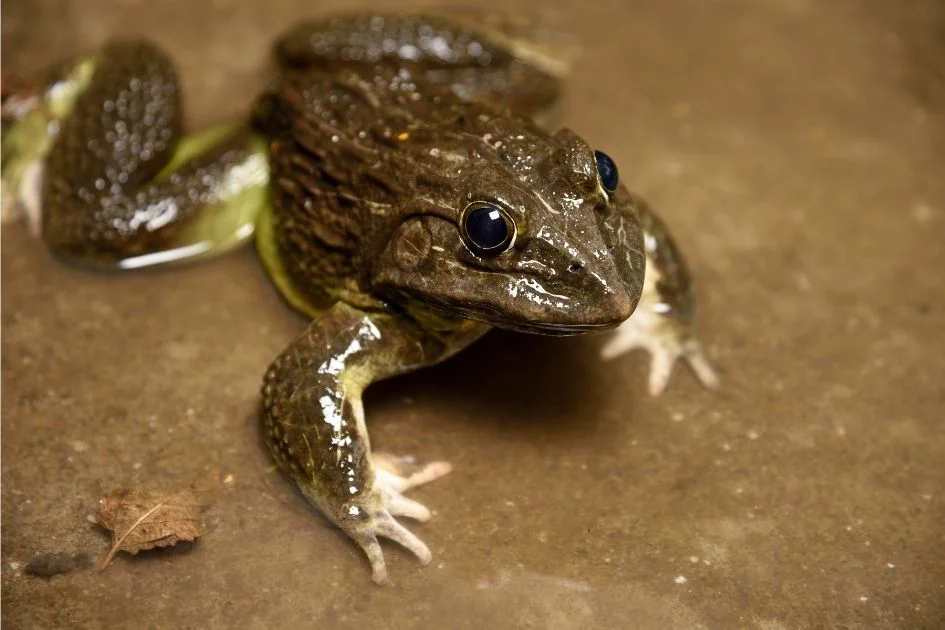
While healthy frogs can survive up to a month without food, the same can’t be said in the case of the absence of water.
And the duration of time frogs will last without water depends on their habitat.
Aquatic frogs survive for a few hours without water, while arboreals can go 24 to 48 hours without water, depending on the frog species.
Learn more about how frogs drink water.
Some Interesting Facts About Frogs
- Tadpoles can slow down or hasten their transformation phase. If a tadpole senses that it’s in a dangerous environment, maybe a pond filled with hungry fishes, it will quicken its metamorphosis to escape. And if it’s in a conducive and safe environment filled with nutritious plants to feast on, it will slow down its transformation.
- Tadpoles have been known to slow down their metamorphosis and remain in the water for up to a year during winter when they sense that the land is extremely cold.
- As far as scientists are concerned, toads and frogs are the same as they share the same family tree. The name “toad” is for frogs with warty skin and shorter hind legs.
- There are over 5,000 species of frogs in existence today.
Frequently Asked Questions
Can frogs die of starvation?
Frogs can die of starvation as a prolonged absence of food causes internal damage and physical complications that can shorten the lifespan of frogs.
However, it’s not common for frogs to search for food before reaching critical stages.
What is the best thing to feed frogs?
Frogs are mainly carnivores and feed on the invertebrates they find around their habitat.
What frogs feed on depends on their sizes, while large frogs feed on small animals such as mice, birds, snails, fish, and even frogs.
Small frogs feed on insects such as crickets, earthworms, caterpillars, beetles, etc.
Wrap-up
So, as you can see, frogs are beautiful creatures if you understand them. They can also be a good addition to the home if you decide to bring one as a pet.
This guide provides some helpful tips to learn about frogs and possibly take good care of them if you decide to make one your pet.
Frogs tend to adapt to limited resources available in their environment to increase their chance of survival.
The presence of predators in the wild is usually the main factor that hampers the frog’s lifespan in the wild.
If not, most frogs in the wild will have a relatively long lifespan like their counterparts raised in captivity.
They can survive for weeks without food and even for months during winter when they’re hibernating.
However, to live a healthy life and thrive comfortably, the frogs should be fed from time to time.
![How Long Can Frogs Go Without Food Or Water [Answered]](https://animalvivid.com/wp-content/uploads/2022/08/How-Long-Can-Frogs-Go-Without-Food-Or-Water-Answered.jpg.webp)
